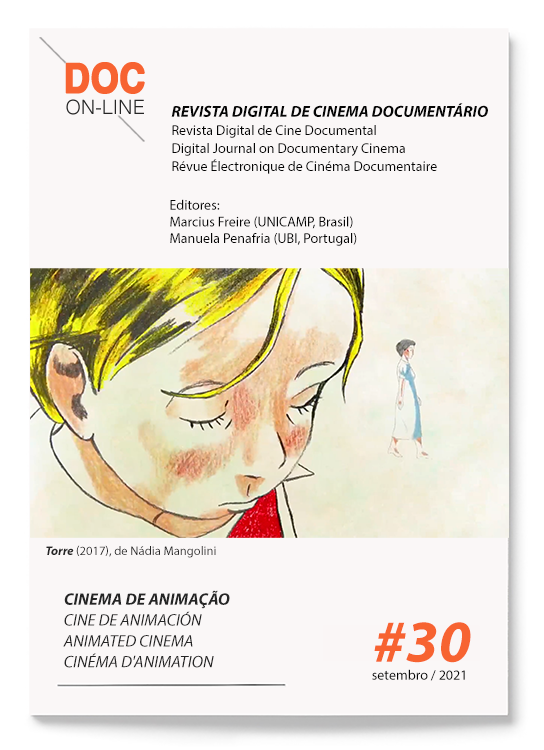John Sutherland e o americanismo: as animações para o Harding College
Palavras-chave:
animação, Sutherland, Harding College, americanismo, anticomunismoResumo
Este artigo analisa os nove documentários de animação produzidos por John Sutherland para o Harding College entre 1948 e 1952. Tendo como norte o americanismo e o anticomunismo, as realizações exaltam as benesses do sistema capitalista e apresentam uma visão negativa do comunismo e de seus agentes. A análise dos aspectos formais e ideológicos dos filmes será feita a partir da “perspectiva histórica”, pois ela permite aprofundar as relações destes com as estruturas econômicas e culturais da sociedade em que foram produzidos.
Referências
Arnold, M. (s.d.). Animating ideas: the John Sutherland story. www.hoganny.com/blog/animating-ideas-the-john-sutherland-story.
Ash, E. (2019, set. 6). Forgotten toons: Hanna-Barbera, anticommunism, and “Make mine freedom” (1948). The Vault of Culture. www.vaultofculture.com/vault/feature/ash/makeminefreedom.
Beauvoir, S. de (2018). Uma existencialista observa os americanos. In S. de Beauvoir, Brigitte Bardot e a síndrome de Lolita e outros escritos (pp. 135-155) (trad. M. Santos & P. Sartori). Quixote + Do Editoras Associadas.
Bogle, L. (2004). The Pentagon’s battle for the American mind: the early Cold War. Texas A & M University Press.
Brianton, K. (2019, ago. 16). Walk east on Beacon. Cinema history. https://cinemahistoryonline.com/2019/08/16/walk-east-on-beacon.
Cohen, K. (s.d.) Animated propaganda during the Cold War: Part two. www.awn.com/animationword/animated-propaganda-during-the-cold-war-parttwo.
Guzmán, P. (2017). Filmar o que não se vê: um modo de fazer documentários (trad. J. Sabino). Edições Sesc São Paulo.
Haas, E., Christensen, T., & Haas, P. (2015). Projecting politics: political messages in American films. Routledge.
Houston, L. (2018). Evangelizing for the American way: the professed mission of Harding, under George S. Benson’s presidency. Tenor o four Times, 7, article 6. https://scholarworks.harding.edu/cgi/viewcontent.cgi?article=1085&context=tenor.
Lewis, T. (2020, fev. 28). National Education Program. CALS, Encyclopedia of Arkansas. https://encyclopediaofarkansas.net/entries/nationaleducation-program-12187/.
Martins, Í. (2009). Documentário animado: experimentação, tecnologia e design. Pontifícia Universidade Católica do Rio de Janeiro.
Mattos, A. (2013). Antropomorfismo na cultura de animação. Instituto de Arte e Comunicação Social/Universidade Federal Fluminense.
Moraes, M. (1999). Simone de Beauvoir e o amor americano (Um tributo a Simone de Beauvoir). Biblioteca Digital da UNICAMP. www.bibliotecadigital.unicamp.br/document/?down=51295.
Neary, N. (2018). Fun and facts about American business: an animated education in the free enterprise system. Northumbria Research Link. http://nrl.northumbria.ac.uk/39992.
Oliveira, O. de (1951, set. 26). Cinema: Fui comunista para o F.B.I. A Manhã.
Ottoni, D. (1950, jun. 27). Cinema: Traidor. Diário Carioca.
Perucci, T. (2012). Paul Robeson and the Cold War performance complex: race, madness, activism. University of Michigan Press.
Quart, L. & Auster, A. (2011). American film and society since 1945. ABCClio.
Rand, A. (1947). Screen guide for Americans. The Motion Picture Alliance for the Preservation of American Ideals.
Robinson, H. (s. d.). The National Education Program on film: highlights from the James D. Bales Project. 365 Mcllroy. https://librariesblog.uark.edu/the-national-education-program-on-film-highlights-from-the-james-d-bales-project/.
S. A. (1949). Freedoms Foundation awards given to fourteen pictures cited for contribution to “American way of life”. Business Screen Magazine, 10(8), 18-19.
S. A. (2014, nov. 1). Ism!. Tralfaz. https://tralfaz.blogspot.com/2014/11/ism.html.
S. A. (2015, jan. 2). A devil of a cartoon. Tralfaz. https://tralfaz.blogspot.com/2015/01/a-devil-of-a-cartoon.html.
S. A. (2020, ago. 8). Why play leap frog?. Tralfaz. https://tralfaz.blogspot.com/2020/08/why-play-leap-frog.html.
S. A.1 (s.d.). I was a Communist for the FBI.Wikipedia. https://en.wikipedia.org/wiki/I_was_a_Communist_for_the_FBI.
S. A.2 (s.d.). Motion Picture Alliance for the Preservation of American Ideals. Wikipedia. https://en.wikipedia.org/wiki/Motion_Picture_Alliance_for_the_ Preservation_of_ American_Ideals.
S. A.3 (s.d.) A song to remember. Wikipedia. https://en.wikipedia.org/wiki/A_Song_to_Remember.
S. A.4 (s.d.). With John Sutherland productions (Stated by popularity ascending). IMBd. www.imdb.com/search/title/?companies=co0025040.
Saunders, F. (2004). La guerra fredda culturale: la CIA e il mondo delle lettere e delle arti. Fazi.
Serra, J. (2011). O documentário animado: quando a animação encontra o cinema do real. USP. www.usp.br/rumores/pdf/rumores10_14_jenifer.pdf.
Serra, J. (2017). A vida animada: (re)construções do mundo histórico através do documentário animado. Instituto de Arte/Unicamp.
Tohline, A. (2009). “Around the corner”: how Jam Hardy’s films reflected and shaped the 1930s and beyond. School of Film/Ohio University.
Whitfield, S. (1996). The culture of the Cold War. The John Hopkins University Press.
Filmografia
Round and Round (1939), da Jam Hardy Organization.
Make mine freedom (1948), de William Hanna e Joseph Barbera (sem créditos).
Going places (1949), de John Sutherland (atribuído). Meet King Joe (1949).
Why play leap frog? (1949), de George Gordon (atribuído).
Albert in Blunderland (1950), de George Gordon (atribuído).
Fresh laid plans (1951), de George Gordon.
Inside Cackle Corners (1951), de George Gordon e Carl Urbano.
The Devil and John Q. (1951), de Carl Urbano.
Dear Uncle (1952), de Carl Urbano.
Downloads
Publicado
Edição
Secção
Licença
A DOC On-line adota uma Licença Creative Commons - Atribuição 4.0 Internacional que permite a partilha do trabalho com reconhecimento da autoria e publicação inicial na DOC On-line, ou seja:
1) Ao submeter um artigo, os autores cedem os seus direitos de primeira publicação à revista DOC On-line.
2) Após publicação na DOC On-line, os autores poderão re-publicar o seu trabalho, online ou em versão impressa, devendo mencionar a publicação original na revista DOC On-line.


